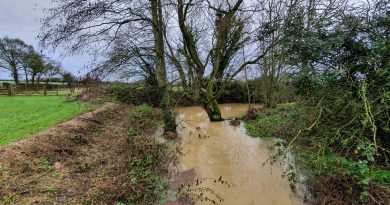South Elmham – St. Michael’s Church
Perhaps the best known fact about the parish of St. Michael in South Elmham is that it’s one of the Thankful Villages, as it lost none of its men during the First World War. And, on top of that, it lost none during the Second World War, one of only 14 villages in the country to be this fortunate.
I was walking in the area with my friend Rob, who mentioned he saw that they were putting new render on the church last year. It is unusual to see a church with such a modern render, as the Victorians frequently stripped it off as part of their modernisations. I do prefer seeing the stone behind the render, but it was a protective layer against water ingress and so churches are a little vulnerable without it.
I’m not a rendering expert, but this looks neat and clean. It’s not quite visible from this photo, although it is from the one below, that the church used to have a thatched roof.
This is the other side of the church, where there is no render, with the wall looking faintly ridiculous and more like something constructed for a shed.
There are no windows on this chancel wall, some of that brickwork at the top looks alarmingly modern and it’s all a bit botched. But, such is the necessity to patch up buildings that have structural issues, although some render here might make the whole edifice look much more appealing. The process of restoration must be frustrating, the church received some extensive work in the early part of the twentieth century, which was much damaged during the storms of February 1906.
The end of the chancel and it’s evident visually that the current building is leaning somewhat in places. And, it’s possible to see the buttressing efforts from previous generations, in their attempt to protect the church.
I found this a rather pretty chancel, despite having no windows on the side walls. Unlike some of the quite sterile designs of some Victorian chancels, the history here is evident.
The chancel wall is leaning, but has been repaired to some extent recently. I’m unclear what that larger bricked up door is, I can only assume that it led to some sort of chantry chapel arrangement.
I do like brick flooring, I think it adds to the atmosphere of the church. There’s one prominent tombstone in the nave, with the bodies of Henry Lone who died in 1727, and his wife Rebecca, who died in 1735. The glass in the windows is quite plain, although that’s because much was lost during the Second World War, but that has meant that the interior is brighter.
The ladder to the top of the tower.
The church’s font dates to the fifteenth century.
This is one of the most beautiful church arches that I’ve seen recently, an original Norman decorated surround which is probably from the twelfth century. The door itself is modern, but the eye is drawn to the arch. Well, mine was.
And a slightly quirky sundial on the exterior of the church.
I thought that this was a quite beautiful church, even ignoring some of the patched walls and that part of the building was leaning. That all adds to the historical attraction of the church, it hasn’t been overly mauled about by the Victorians (although they did replace the seating and boarded up some of the roof) and it still feels medieval. The churchyard is moated, which is an historic quirk by nature of being next to a common, and the church itself is Grade I listed.
The first child to be baptised in the church’s fifteenth century font would have been a Catholic and the religious set-up would have been different. But yet, there’s that reassuring feeling that really not much has changed in this church since then. If the parents of that child being baptised looked up and down the church as it is today, I suspect they wouldn’t have been much surprised at the changes. Well, unless someone got a phone out and took a photo, but otherwise, this is a little piece of what England was once like.
















